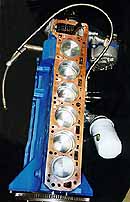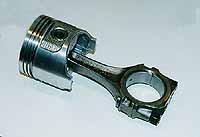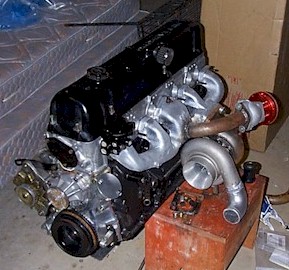
Contributed By: James Thagard
James is currently a Ph.D Candidate at FSU College of Engineering
and can be reached via E-Mail just click here: To James Thagard

Last Up-dated: 11 Aug. 99..
This section describes the mods needed to build a 400-500hp
turbocharged L-28 motor.
The list of modifications in this section is guidelines and outline
minimal modifications to have a reliable motor. Other tricks and prep work
can be done outside of what is described in this section.
Block
You will want to obtain a turbo block, which can be differentiated from other blocks by the "F54" that is cast onto the driver's side of the block. This block has extra webbing internally that provides added strength and increases block rigidity. In talking with Don Potter, a Guru on turbocharging the L motor, he actually recommends using an early 280 block. He says the extra webbing restricts the flow of coolant to the last 2 cylinders causing them to run hotter than cylinders 1-4. Although this is true, extensive mods and prep work have to be done to the block to prepare it for use. This includes modifying the water jackets, cryogenically treating the block and so on. This is not practical for street and track use on a motor under 600hp.
You will want to start by having the block cleaned by vat or steam cleaning. Remember the block is critical because it is the hub for oiling all of the components within the motor and also the turbocharger. You will need to have all the oil passages cleaned thoroughly to ensure that there are no blocked passages.
MORE TO COME

Pistons
Not too much to say except you better get a good set of forged pistons. This will typically run between $600-$800 depending on which supplier you use and what sort of deal you get. I use Venolia forged and have had great success, others swear by JE forged. Both have a good reputation and both will be suitable for this application. Make sure you tell whoever is getting the piston that it is for turbocharging. Also, piston design and ring location is critical for high hp turbo applications. My piston is a flattop piston that I got when I 1st purchased the motor from a guy. In actuality, flattop or dished is a function of combustion chamber configuration/design. Meaning the design of the chamber to be used will strongly dictate piston top configuration. The P-90 head was actually designed for the dished piston, although flattop pistons will work fine. It really becomes critical when you are going for efficiency of your motor and trying to make mucho hp in the range of 550-600+++hp. I know some of you are saying, well my buddy makes 400+hp and he uses the stock pistons. Tell your buddy congratulations and he is not the 1st person to do it. Look back up to the top of this article where it says, "Reliable!" The room for error and the resistance to withstand any detonation is reduced to almost 0. I have a seen several people make the power and a few months later I was hearing how they melted or cracked a piston. Rebello and Top-End Performance already have a line on pistons for any configuration you need depending on head/block/rod/gasket used. Also, make sure you get pins that were designed for your piston. One last thing, ceramic coating of the piston tops. Some people swear by it and some people have said it really doesn't make a lick of difference. Personally, I did not have this done to my pistons. If your engine management is in order, I would think it not necessary, but if it makes you feel better, have it done!
Rods
The rods are very critical in the reliability of your new turbo motor. Typically, anything under 400hp requires little rod prep. Prep for a sub 400hp motor would include balancing, resizing the big end and using ARP rod bolts. Once you pass the 400hp level, the integrity of the stock rod comes into question. You will need to start by obtaining a set of L-28 rods. Before any prep work is done you will want to have them Magnafluxed or sonic tested. This will let you know if your rods have any internal cracks that would not otherwise be visually detected. No sense prepping a rod that you are not sure of. After you sonic test the rod, you will want to have the big end of the rod resized and ARP Rod bolts installed. Using ARP is a must, rod failure is often due to stock bolts being used in high revving, high hp applications. Resizing assures that proper dimensions are obtained for bearing clearance and for reference for bushing the small end of the rod. Next, you will want to have the small end of the rod bushed for full-floating pistons. From my experience, you must have your shop use a suitable material for the bushings. I have worn out 2 sets of bushings in a matter of months. Having to tear down the motor is time consuming and expensive. Magnesium bronze or Silicone bronze is often used for the bushing material. Remember, clearance between pin and bushing is on the order of .0005". Make sure you use the pin that was made for your forged pistons. Next, you will want to have the rods shot peened. This relieves any stresses that are inherent within the casting of the rod. After the shot peening you will want to have the rods polished. Polishing the rods rids the rod of imperfections on the surface. Remember, because the surface of a stock rod is not smooth, peaks and valleys on the surface, each valley is an area of high stress concentration. I had the whole thing done for $350. This may seem a bit much, but after going through 2 sets of bushings I wanted it done right!

Crank
The crank is one part of the motor that can easily become the most expensive component. Yes, you can buy a nice forged chunk for about $2500 or you can just send me the money and I will provide you with a nice raceprepped stock crank for well under $1000. I suppose when I build my ultimate motor, I will swallow deep and pay the money for a custom forged crank. But for 99% of the applications, the stock crank that has been preppared will do the job nicely. Don't worry about it handling the power, it can live in the 600hp+ range if done properly. One thing that greatly increases the pricetag on your crank is the RPM inwhich you plan to make power. True, a 240z crank will rev higher with less prep than a 280 crank because of the reduced arm, but a properly prepped L28 crank should rev to 8K rpm if done properly. The faster you want the motor to spin, the more money it will cost you. As the RPMs increase, the attention to detail in the crank prepparation increases. The crank will actually begin to deflect at higher RPMs that can eventually lead to crank failure. This is probably more apparent on road race cars as they have long extended periods of high RPM use. OK, have I actually said anything as of yet on what needs to be done to your crank? If you think this is bad, wait until I get to the section on selecting a turbocharger! OK, for our purposes of 400-500hp and realizing that we will probably not rev much over 7K RPM, depending on our setup, I will stick with what is to be done for the L28 crank to survive. Typically, you will want to have the crank turned .010" on the mains and rods if needed. Some people like to turn the crank just for posterity. I usually have it turned regardless of the condition of the crank. You will also want to remove the oil galley plugs and have them tapped. It is always a good idea to have your crank heat treated which will go a long way to extending the life of your turbo motor. FYI, my current motor runs a non-heat treated raceprepped crank that runs in excess of 400hp and pulls to 6.8K RPM with no problems. I think if you are going to build you a masterpiece of an engine, you should not skimp on getting it heat treated. You know the old saying, "do as I say, not as I do." I have friends who produce in excess of 400hp and have not touched the crank, but in my opinion, all of the detail will pay off in the end as you will have a rock solid turbo motor. That is pretty much it for the reliability aspect of prepping your crank. You can have additional things done to the crank that will allow you to rev your motor to 8K, but I think you will find that the car produces plenty of power under 7K RPM and will give you one hell of a ride. We can address balancing further down in the article. If you are like me and want to explore destroked/stroked turbo motors, give SunBelt Race Engines(Atlanta) or Rebello Race Engines a call and see what prep work the recommend for the L24 and LD28 cranks.
Head Gasket
The other article on this sight says, "You MUST O-ring either the head or block. I prefer the block because you don't have to redo it every time you clean up the head." O-ringing the block is not a MUST. You have several choices to choose from. You can use the stock head gasket, where you would need to o-ring the block or you can use the HKS metal head gasket where o ringing is not necessary. You can safely run 10psi of boost with the stock head gasket and no o ringing. I have had friends run 17+psi with stock gasket and no o ringing, but they were replacing their head gasket ever so often at those levels. Anything over 10psi, I would recommend using the HKS for longevity sake. I ran the HKS for over 1-year w/no o ringing and no problems with 18-19psi of boost daily. And believe me when I say I floored it all the time. Being all-metal, you cannot blow it out like a stock gasket. I have heard people having sealing problems when using the HKS, but I have not had any problems. Using copper spray has worked for me, but not others. Fel-Pro makes a Blue gasket sealant that is recommended for this application. I will let you know the exact name when I look it up again.
Head
Oh boy, this section is a tough one. Why you ask? Well, we can produce 400+hp with the stock head and only minor port mathing of the intake/exhaust ports. Of course, this is not the most efficient way of making the power. Knowing this, I will list the mods that are done to my new head and you can decide how far you can/willing to go on the modifications. Let us start with the easy stuff first. I would say that SS intake/exhaust valves are a must. Once again, you can make 400+hp with stock valves, but your motor will not last a long time. You will find it a problem to find SS valves for the P90 head unless you have them made custom for that head. This is because the valves are .080" shorter than valves on all other L heads, excluding P79. I bought the SS valves for the non P90/P79 head and adapted them to fit. This required that my cam towers be shimmed .045" and then the appropriate lash pad used to get the correct geometry on the rocker. I had (Pro-Am Parts) in Houston set up my cam after having the head built. You had better make sure this is done correctly or you will have a flattened cam lobe and plenty of nice metal shavings throughout your motor. Trust me, I have been there!
Turbo
My favorite section of this article.

MORE TO COME
Intake Manifold
MORE TO COME
Exhaust Manifold
MORE TO COME
Exhaust
MORE TO COME